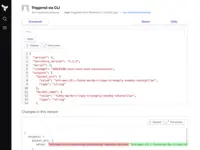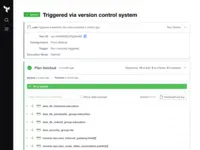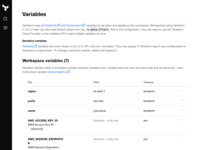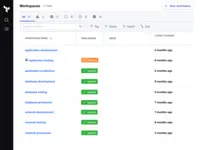Starting at $0
View PricingOverview
What is HashiCorp Terraform?
Terraform from HashiCorp is a cloud infrastructure automation tool that enables users to create, change, and improve production infrastructure, and it allows infrastructure to be expressed as code. It codifies APIs into declarative configuration files that can be shared amongst…
Recent Reviews
Reviewer Pros & Cons
Pricing
Open Source
$0
Cloud
Team & Governance
$20/user
Cloud
per user/per month
Enterprise
Contact sales team
Cloud
Entry-level set up fee?
- No setup fee
For the latest information on pricing, visithttps://www.hashicorp.com/products/terr…
Offerings
- Free Trial
- Free/Freemium Version
- Premium Consulting/Integration Services
Product Demos
Infrastructure Pipelines with Terraform Cloud
YouTube
Product Details
- About
- Competitors
- Tech Details
- FAQs
What is HashiCorp Terraform?
HashiCorp Terraform is an infrastructure as code tool that lets the user define both cloud and on-prem resources in human-readable configuration files that the user can version, reuse, and share. A consistent workflow can then be used to provision and manage infrastructure throughout its lifecycle. Terraform can manage low-level components like compute, storage, and networking resources, as well as high-level components like DNS entries and SaaS features.
Terraform creates and manages resources on cloud platforms and other services through their application programming interfaces (APIs). Providers enable Terraform to work with virtually any platform or service with an accessible API.
Terraform creates and manages resources on cloud platforms and other services through their application programming interfaces (APIs). Providers enable Terraform to work with virtually any platform or service with an accessible API.
HashiCorp Terraform Features
- Supported: Manage any Infrastructure
- Supported: Track your infrastructure
- Supported: Automate changes
- Supported: Standardize configurations
HashiCorp Terraform Screenshots
HashiCorp Terraform Competitors
HashiCorp Terraform Technical Details
| Deployment Types | Software as a Service (SaaS), Cloud, or Web-Based |
|---|---|
| Operating Systems | Unspecified |
| Mobile Application | No |
Frequently Asked Questions
Terraform from HashiCorp is a cloud infrastructure automation tool that enables users to create, change, and improve production infrastructure, and it allows infrastructure to be expressed as code. It codifies APIs into declarative configuration files that can be shared amongst team members, treated as code, edited, reviewed, and versioned. It is available Open Source, and via Cloud and Self-Hosted editions.
Red Hat Ansible Automation Platform, Jenkins, and GitHub are common alternatives for HashiCorp Terraform.
Reviewers rate Performance highest, with a score of 9.4.
The most common users of HashiCorp Terraform are from Enterprises (1,001+ employees).











